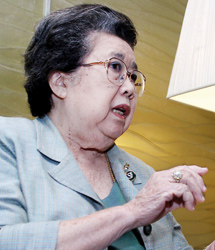Battling the deadly sting for 54 years
Dengue Haemorrhagic Fever (DHF) kills, if not diagnosed and clinical management is not followed to the letter.
This is the clear message that well-known dengue expert, Prof. Suchitra Nimmannitya from Thailand, acclaimed as the “clinician with the longest experience” with regard to this viral disease, gave to Sri Lanka during a visit last month when she spoke about ‘My journey along the dengue trail’.

Pic by Indika Handuwala
She has the knowledge about this deadly disease and how to fight it at her fingertips, because it has been her passion for 55 long years. When Thailand was struggling under the first dengue epidemic way back in 1958, she had witnessed its full horror, as a fresh-faced young doctor
Pointing out that dengue affects people across all strata, she creates the image of a population becoming vulnerable not only due to growth but also due to upward mobility economically. With more vehicles plying the streets, discarded tyres become the breeding grounds for mosquitoes.
Citing an example, 82-year-old Prof. Suchitra recalls how the tiny mosquito which spreads dengue, Aedes aegypti was controlled in South America, but the moment that region began importing old tyres from Asia, the trouble started. “The dengue-spreading mosquitoes’ eggs can resist heat and dry spells for one year,” she lamented.
Recalling dengue’s wrathful trail, she says that before 1981 there was only Dengue Fever (DF) but not DHF. Deadly DHF came after that and it has been found that repeated infections with dengue cause severe DHF.
Depending on the sequencing (DF1, DF2, DF3 or DF4) of repeated infections in any person, the chances of becoming a victim of DHF are higher. Certain combinations of the dengue virus types in subsequent infections will be a deciding factor whether the person will develop DHF or not, she points out.
While usually DF is not fatal, what is important is to prevent a patient with DHF from going into shock. This would help save almost everyone who gets DHF, is Prof. Suchitra’s simple but workable logic. Referring to diagnosis, acute high fever is a major manifestation of dengue and early diagnosis is important, according to her. When the fever drops, if the patient has been suffering from DF, he/she will bounce back to normal and begin eating well. However, in DHF even when the fever drops or the febrile phase is over, a flushed face, rapid pulse, white platelet count drop and rise in haematocrit will be danger signs that the critical phase with fluid leakage will begin. This could be about the third or fourth day or even after a week.
The patient is still ill and tiny red spots may appear on the skin, the white blood cell count would be low and the platelet count would drop. There would be a tendency to bleed and for plasma leakage into the pleural (lung) spaces and the abdomen, with the patient going into shock. “If the patient goes into shock, the medical team needs to be by his/her bedside all the time,” urges Prof. Suchitra.
Prolonged shock would result in poor circulation. This is the time to be very careful and give just the right amount of fluid to keep the blood circulation effective. “It should not be over or under,” she cautions, as when the leakage stops and fluid re-absorption begins, an overload or hyper-volume will cause distress, with the fluid compressing the lungs.
The signs of recovery from DHF will come with the patient’s appetite improving, vital signs picking up and urine output being good.
Meanwhile, if an expectant mother has DF before delivery, there could be vertical transmission to the baby at the time of birth. Then the baby could develop dengue within a few days after birth, says Prof. Suchitra, recalling a case where a newborn had got dengue within 16 hours of birth.
Advice to parents from this dengue expert
- If your child is running a high temperature, try to bring it down the traditional way by sponging with a warm, wet towel while the child is under a fan.
- Give only paracetamol and that too the right dosage at the right time. Don’t overdose the child with paracetamol.
- Even if non-steroidal anti-inflammatory drugs (NSAIDS) such as ibuprofen, mefenamic acid and diclofenac sodium are prescribed in the very early stages of fever, they will do harm. Therefore, it’s a big “No, no” to NSAIDS, when a child is having fever.
- Over-medication with any drugs also affects the liver.
- Rehydration is important with fruit juices.
- Take the child to the doctor if the fever persists more than two days and question the doctor if he prescribes anything other than paracetamol.


